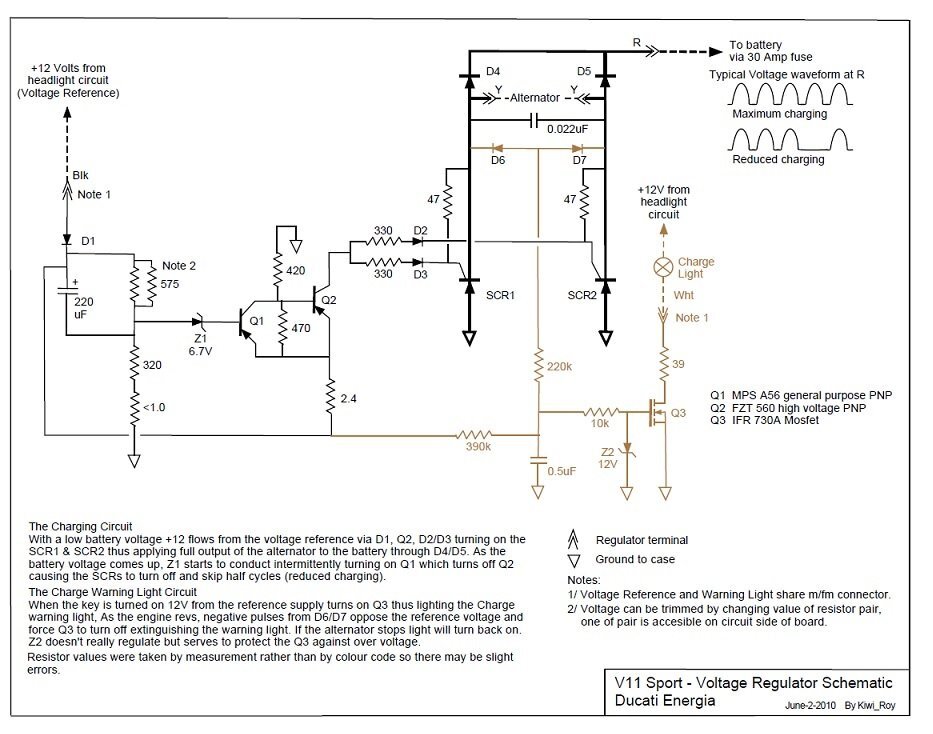-
Posts
1,613 -
Joined
-
Last visited
-
Days Won
64
Content Type
Profiles
Forums
Events
Gallery
Community Map
Everything posted by Pressureangle
-
The lamp itself can illuminate with far less than 12 volts, so the lit lite doesn't tell us the circuit voltage is good. I'm curious about the headlamp too, LEDs are internally regulated to about 5vdc so even if for instance the headlight circuit is only getting 8vdc the LEDs are still bright. I'm trying not to confuse the OP, or myself, by theorizing too much before he can catch up on physical diagnostics.
-
So, no, the charge lamp does not 'activate' the regulator. The headlamp circuit supplies voltage to both the regulator and the charge lamp, and the internals of the regulator do in fact 'balance' the voltage to the indicator lamp. With regards to our symptoms, the lamp is a clue; it will be dark *any time* the headlamp circuit is dead...and most of the time while it's live. The only time the lamp is *supposed* to come on is when the Battery, via the HL circuit, has more voltage than the regulator is outputting.
-
I screenshot KiwiRoy's schematic so we can see it more easily. It says clearly that the voltage reference comes from the headlamp circuit. Have to go back to see if the bulb is in that circuit or not.
-

Motorcycle Grand Tour of Texas, 2025 edition.
Pressureangle replied to p6x's topic in Meetings, Clubs & Events
I can't speak to how Garmin works on my Win7 PC lol -

Motorcycle Grand Tour of Texas, 2025 edition.
Pressureangle replied to p6x's topic in Meetings, Clubs & Events
-
We discovered at the SSR a couple years ago that the taillight on my 'Sport would come on by itself after an hour or so. No key anywhere. Relevant to this thread, it was the ignition switch goo come to life as a capacitor.
-
Was kinda my point. Probably won't crash, will in all certainty tip over in a parking lot.
-
Well, mine needs paint and has clipons.
-
Yeah baby...
-
Awesome. So as Phil said early, the headlight circuit is the voltage reference source, and the regulator actually uses reference to turn the lamp on and off, not a simple balancing act. So now there are 2 considerations, the reverence voltage and the delivery voltage. Easy enough to verify reference, via connectors all the way to the regulator. If the reference matches battery voltage *with key on*, then it's a delivery problem; that has 2 elements, the VR itself and the delivery circuit.
-
Yes, complicated for a novice but as easy as it can be while being complete. I'm hoping for something obvious like the charge wire, but it's starting to feel like a bad component. I wish it was clear whether the lamp wire is a voltage sense source, or simply a lamp balancing act.
-
Plugs to stock harness, has charge lamp circuit. Should be a no-brainer. 'Still collating data', Ash would say.
-
Feh, I'm far more likely to tip it over in the gravel parking lot at zero mph than to actually crash it. If I tip over, saved the pipes. If I crash it, I doubt the head guards will add much to the bill, and might save the pipe. And at least currently, the heads are available whereas Daytona heads, not so much.
-
Ok, let's get serious. Documented points of failure; 30a fuse, fuse holder, wire terminals Charge wire to battery Yellow gen-to-VR wires (I had this one, and the bike I have up right now shows heat burns at the junction, even though they've had the connectors eliminated) Since you have a non-stock VR, let's have a pic so we can see the wires; I have a Shindengen on my Aermacchi, it has 3 yellow inputs, a ground, and a battery charge wire. There is no separate sensor wire, or 'illumination' wire for a charge lamp. Yours must have a lamp wire? To test a wire where there is no access, you have to puncture it- not a fan. Your generator is making voltage, you still seem worried about how high it is; a permanent magnet generator makes voltage as a function of RPM so it's normal and nothing to worry about. The next steps are; 1. See that generator voltage is received at the VR. I would allow the assumption that if you make a firm connection at the yellow wire junctions, this is true. 2. See that the VR is giving 13.5-15volts DC as near to the VR as you can measure- the first connection. You can measure this without disconnecting the VR from the system. 3. If the VR has voltage, you have to confirm voltage without drop across every connection and wire all the way to the battery. You need a test light for this, as a DMM can measure open circuit voltage that has no amperage and you can't tell. A test lamp demands current to light. The DMM can measure voltage drop across a connection, you should never have more than *-.05v* across any connection. Between the two devices you can chase the fault all the way back to the battery. If the VR never makes more than 13v, or if it makes above 15, it's suspect but still subject to measuring voltage across faulty connections. A good starting place is the fuse block. Every fuse should always have full battery voltage. If you find that any fuse measures less voltage than the battery itself, either key off or engine running, you have a faulty connection. Have a good look at the ring terminals that attach to the battery itself, to see that they're not corroded beneath the insulation.
-
After having a BMW for 20k miles now, and a little history, it's my belief that BMW and MG have worked closely together for some time; not partnership, but fundamentals. In the beginning of the Italian V-twin era, I think everyone saw how sound the BMW flat twin was, the shaft drive, and removed the biggest impediment to racing them- the flatness. Plus, being Mountain Italians they gave them frames that worked and of course instantly recognized the romantic sound. Looking at the Lambretta frame above, it's clear that it's very similar to Aermacchi frames. I think the Bavarians and ItAlpians went to the same schools. Or ski trips, or wars, or something.
-
Has someone replaced the instrument warning lamps with LED? The charge lamp, with the stock or stock-arranged VR needs an incandescent bulb to work. By the schematic, the headlamp bulb itself has no effect- it takes power from the same wire but isn't between the charge lamp and regulator.
-

Roper plates and occasional other bits
Pressureangle replied to Pressureangle's topic in Personal Ads
Surely- but I can't say just what the cost might be- may be less expensive to order a bag of 30 direct from the source. Lemme find it. Got them here- I'm sure they'd be glad to send direct. https://www.ebay.com/itm/235492214044?_skw=10pcs+sf-1+0808+self+lubricating+bearing+bushing+sleeve+8+x+10+x+8mm&itmmeta=01K555MNR051M09HMSJM535H5A&hash=item36d46e051c:g:AusAAOSwkuVbUCh8 -
Was that tightening or loosening? Looks like you might still have a bit sticking above the gasket surface.
-

best place to get red valve covers & matte grey frame plates?
Pressureangle replied to fastaussie's topic in 24/7 V11
You should see what I do to myself. I buy bikes a breaker may not pay for and try to rehabilitate them. -
I figured since this subforum doesn't move much it's a good place to stick and edit for sale stuff... Roper slosh plates, obviously (Rusty star picket project) I bought throttle body bushings, and since I have 3 bikes that take the same ones I bought a bag of 30 to get the discount. Had to order offshore and took 2 weeks- odd size in the US. If anybody wants a set, I'll send them along for postage and a donut. CA cycleworks has the seals. I'm going to find a set of common injectors and have them ready to ship out, that way members can have them on hand for a quick swap, and send theirs to me without losing ride time. I made a nice stainless replacement rod for my rusty TB linkage. I don't have ends but swap yours on or find new from Volvo, Yamaha etc. $35 shipped to US. One day I'll have the plastic adjustment knobs for the TB linkage. In the works but not yet available.
-

best place to get red valve covers & matte grey frame plates?
Pressureangle replied to fastaussie's topic in 24/7 V11
Eeee...ooooh... I think you're looking at anodizing or powdercoating. New parts are at best hard to find, and those pieces in particular seems unlikely, in good condition. -

V11 misfire around 2000 rpm, or in need of mapping?
Pressureangle replied to fastaussie's topic in Technical Topics
Rut Roh the Demon raises it's ugly head again. I think Power Commanders are universally despised by anyone not selling them. Before any root cause can be determined, a thorough precision tune-up is mandated. Also, both my '97 1100 Sport-i and my 2000 V11 Sport had a large differential in the injectors. After a quarter century, they need serviced. https://www.injectorrx.com/ -
The shorter list is 'what have I *not* f'd up through the years'.
-
Yes, it is. Current should flow through the ignition switch, fuse, headlight switch, and up to the tach where it passes through to the charge lamp; the regulator seeing no input from the generator passes that current through to ground, illuminating the lamp. When the generator charges the regulator, it puts an opposing charge back into the lamp wire. When these are balanced, the lamp is dark. So it seems likely that you have a problem on the power side of the regulator with a less likely possibility that the regulator has some weird internal failure. A simple test would be key-on engine off test light (not DMM) at the lamp wire + post on the back of the tach. No light, no current.







